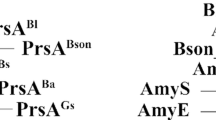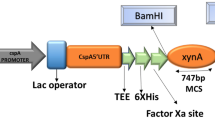Abstract
Xylanases are industrially important enzymes for xylan digestion. We experimentally screened over 114 Sec and 24 Tat pathway signal peptides, with two different promoters, for optimal production of an alkaline active xylanase (XynBYG) from Bacillus pumilus BYG in a Bacillus subtilis host. Though both promoters yielded highly consistent secretion levels (0.97 Pearson correlation coefficient), the Sec pathway was found to be more efficient than the Tat pathway for XynBYG secretion. Furthermore, the optimal signal peptide (phoB) for XynBYG secretion was found to be different from the optimal peptides for cutinase and esterase reported in previous studies. A partial least squares regression analysis further identified several statistically important variables: helical properties, amino acid composition bias, and the discrimination score in Signal P. These variables explain the observed 23 % variance in the secretion yield of XynBYG by the different signal peptides. The results also suggest that the helical propensity of a signal peptide plays a significant role in the beta-rich xylanase, but not in the helix-rich cutinase, suggesting a coupling of the conformations between the signal peptide and its cargo protein for optimal secretion.



Similar content being viewed by others
References
Battan B, Sharma J, Dhiman SS, Kuhad RC (2007) Enhanced production of cellulase-free thermostable xylanase by Bacillus pumilus ASH and its potential application in paper industry. Enzym Microb Technol 41(6–7):733–739. doi:10.1016/j.enzmictec.2007.06.006
Bien TLT, Tsuji S, Tanaka K, Takenaka S, Yoshida K (2014) Secretion of heterologous thermostable cellulases in Bacillus subtilis. J Gen Appl Microbiol 60(5):175–182. doi:10.2323/jgam.60.175
Brockmeier U, Caspers M, Freudl R, Jockwer A, Noll T, Eggert T (2006) Systematic screening of all signal peptides from Bacillus subtilis: a powerful strategy in optimizing heterologous protein secretion in gram-positive bacteria. J Mol Biol 362(3):393–402. doi:10.1016/j.jmb.2006.07.034
Caspers M, Brockmeier U, Degering C, Eggert T, Freudl R (2010) Improvement of Sec-dependent secretion of a heterologous model protein in Bacillus subtilis by saturation mutagenesis of the N-domain of the AmyE signal peptide. Appl Microbiol Biotechnol 86(6):1877–1885. doi:10.1007/s00253-009-2405-x
Degering C, Eggert T, Puls M, Bongaerts J, Evers S, Maurer KH, Jaeger KE (2010) Optimization of protease secretion in Bacillus subtilis and Bacillus licheniformis by screening of homologous and heterologous signal peptides. Appl Environ Microbiol 76(19):6370–6376. doi:10.1128/AEM.01146-10
Dodd D, Cann IKO (2009) Enzymatic deconstruction of xylan for biofuel production. GCB Bioenergy 1(1):2–17. doi:10.1111/j.1757-1707.2009.01004.x
Fonseca-Maldonado R, Vieira DS, Alponti JS, Bonneil E, Thibault P, Ward RJ (2013) Engineering the pattern of protein glycosylation modulates the thermostability of a GH11 xylanase. J Biol Chem 288(35):25522–25534. doi:10.1074/jbc.M113.485953
Fu LL, Xu ZR, Li WF, Shuai JB, Lu P, Hu CX (2007) Protein secretion pathways in Bacillus subtilis: implication for optimization of heterologous protein secretion. Biotechnol Adv 25(1):1–12. doi:10.1016/j.biotechadv.2006.08.002
Guerout-Fleury AM, Frandsen N, Stragier P (1996) Plasmids for ectopic integration in Bacillus subtilis. Gene 180(1–2):57–61. doi:10.1016/S0378-1119(96)00404-0
Heffernan R, Paliwal K, Lyons J, Dehzangi A, Sharma A, Wang JH, Sattar A, Yang YD, Zhou YQ (2015) Improving prediction of secondary structure, local backbone angles, and solvent accessible surface area of proteins by iterative deep learning. Sci Rep 5:11476. doi:10.1038/Srep11476
Isogai Y, Nemethy G, Rackovsky S, Leach SJ, Scheraga HA (1980) Characterization of multiple bends in proteins. Biopolymers 19(6):1183–1210. doi:10.1002/Bip.1980.360190607
Juturu V, Wu JC (2012) Microbial xylanases: engineering, production and industrial applications. Biotechnol Adv 30(6):1219–1227. doi:10.1016/j.biotechadv.2011.11.006
Kawashima S, Kanehisa M (2000) AAindex: amino acid index database. Nucleic Acids Res 28(1):374
Kulkarni N, Chauthaiwale J, Rao M (1995) Characterization of the recombinant xylanases in Escherichia coli from an alkaliphilic thermophilic Bacillus sp Ncim-59. Enzym Microb Technol 17(11):972–976. doi:10.1016/0141-0229(94)00144-8
Levitt M (1976) A simplified representation of protein conformations for rapid simulation of protein folding. J Mol Biol 104(1):59–107
Longhi S, Mannesse M, Verheij HM, DeHaas GH, Egmond M, KnoopsMouthuy E, Cambillau C (1997) Crystal structure of cutinase covalently inhibited by a triglyceride analogue. Protein Sci 6(2):275–286
Maat J, Roza M, Verbakel J, Stam H, Dasilva MJS, Bosse M, Egmond MR, Hagemans MLD, Vongorcom RFM, Hessing JGM, Vanderhondel CAMJJ, Vonrotterdam C (1992) Xylanases and their application in bakery. Prog Biotechnol 7:349–360
Mathiesen G, Sveen A, Brurberg MB, Fredriksen L, Axelsson L, Eijsink VGH (2009) Genome-wide analysis of signal peptide functionality in Lactobacillus plantarum WCFS1. BMC Genet 10. doi:10.1186/1471-2164-10-425
Miller GL (1959) Use of dinitrosalicylic acid reagent for the determination of reducing sugar. Anal Chem 31:426–428
Nakashima H, Nishikawa K (1992) The amino-acid-composition is different between the cytoplasmic and extracellular sides in membrane-proteins. FEBS Lett 303(2–3):141–146. doi:10.1016/0014-5793(92)80506-C
O’Neil KT, DeGrado WF (1990) A thermodynamic scale for the helix-forming tendencies of the commonly occurring amino acids. Science 250(4981):646–651
Oakley AJ, Heinrich T, Thompson CA, Wilce MCJ (2003) Characterization of a family 11 xylanase from Bacillus subtilis B230 used for paper bleaching. Acta Crystallogr Sect D 59:627–636. doi:10.1107/S0907444903001227
Petersen TN, Brunak S, von Heijne G, Nielsen H (2011) SignalP 4.0: discriminating signal peptides from transmembrane regions. Nat Methods 8(10):785–786. doi:10.1038/nmeth.1701
Richardson JS, Richardson DC (1988) Amino-acid preferences for specific locations at the ends of alpha-helices. Science 240(4859):1648–1652. doi:10.1126/Science.3381086
Robson B, Suzuki E (1976) Conformational properties of amino-acid residues in globular proteins. J Mol Biol 107(3):327–356. doi:10.1016/S0022-2836(76)80008-3
Sambrook J, Fitsch EF, Maniatis T (1989) Molecular cloning: a laboratory manual. Cold Spring Harbor Press, Cold Spring Harbor
Selle PH, Ravindran V, Partridge GG (2009) Beneficial effects of xylanase and/or phytase inclusions on ileal amino acid digestibility, energy utilisation, mineral retention and growth performance in wheat-based broiler diets. Anim Feed Sci Technol 153(3–4):303–313. doi:10.1016/j.anifeedsci.2009.06.011
Tjalsma H, Bolhuis A, Jongbloed JDH, Bron S, van Dijl JM (2000) Signal peptide-dependent protein transport in Bacillus subtilis: a genome-based survey of the secretome. Microbiol Mol Biol Rev 64(3):515–547. doi:10.1128/Mmbr.64.3.515-547.2000
Viikari L, Kantelinen A, Sundquist J, Linko M (1994) Xylanases in bleaching—from an idea to the industry. FEMS Microbiol Rev 13(2–3):335–350. doi:10.1111/J.1574-6976.1994.Tb00053.X
Wang J, Zhang WW, Liu JN, Cao YL, Bai XT, Gong YS, Cen PL, Yang MM (2010) An alkali-tolerant xylanase produced by the newly isolated alkaliphilic Bacillus pumilus from paper mill effluent. Mol Biol Rep 37(7):3297–3302. doi:10.1007/s11033-009-9915-6
Wilce MCJ, Aguilar MI, Hearn MTW (1995) Physicochemical basis of amino-acid hydrophobicity scales—evaluation of 4 new scales of amino-acid hydrophobicity coefficients derived from Rp-Hplc of peptides. Anal Chem 67(7):1210–1219. doi:10.1021/Ac00103a012
Wu SC, Qureshi MH, Wong SL (2002) Secretory production and purification of functional full-length streptavidin from Bacillus subtilis. Protein Expr Purif 24(3):348–356. doi:10.1006/prep.2001.1582
Yang MM, Zhang WW, Zhang XF, Cen PL (2006) Construction and characterization of a novel maltose inducible expression vector in Bacillus subtilis. Biotechnol Lett 28(21):1713–1718. doi:10.1007/s10529-006-9146-z
Yang MM, Zhang WW, Bai XT, Li HX, Cen PL (2010a) Electroporation is a feasible method to introduce circularized or linearized DNA into B. subtilis chromosome. Mol Biol Rep 37(5):2207–2213. doi:10.1007/s11033-009-9704-2
Yang MM, Zhang WW, Chen YL, Gong YS (2010b) Development of a Bacillus subtilis expression system using the improved Pglv promoter. Microb Cell Factories 9:55. doi:10.1186/1475-2859-9-55
Zhang T, Faraggi E, Xue B, Dunker AK, Uversky VN, Zhou Y (2012) SPINE-D: accurate prediction of short and long disordered regions by a single neural-network based method. J Biomol Struct Dyn 28(4):799–813
Zhu FM, Ji SY, Zhang WW, Li W, Cao BY, Yang MM (2008) Development and application of a novel signal peptide probe vector with PGA as reporter in Bacillus subtilis WB700: twenty-four tat pathway signal peptides from Bacillus subtilis were monitored. Mol Biotechnol 39(3):225–230. doi:10.1007/s12033-008-9030-2
Acknowledgments
This study was financially supported by the National Science Foundation of China (31372343 and 3137228). This work was also supported by funding from an innovation project of science and technology plan project of Shaanxi Province, China (2014KTCL02-21), and a Ministry of Agriculture (No. 2013-S16) to X.Z.; National Health and Medical Research Council (1059775 and 1083450) of Australia and Australian Research Council’s Linkage Infrastructure, Equipment and Facilities funding scheme (project number LE150100161) to Y.Z., National Natural Science Foundation of China (61271378) to Y.Y. We also gratefully acknowledge the support of the Griffith University eResearch Services Team and the use of the High Performance Computing Cluster “Gowonda” to complete this research. This research/project has also been undertaken with the aid of the research cloud resources provided by the Queensland Cyber Infrastructure Foundation (QCIF).
Author information
Authors and Affiliations
Corresponding authors
Ethics declarations
This article does not contain any studies with human participants or animals performed by any of the authors.
Conflict of interest
The authors declare that they have no competing interests.
Additional information
Weiwei Zhang and Mingming Yang are co-first authors.
Electronic supplementary material
ESM 1
(PDF 291 kb)
Rights and permissions
About this article
Cite this article
Zhang, W., Yang, M., Yang, Y. et al. Optimal secretion of alkali-tolerant xylanase in Bacillus subtilis by signal peptide screening. Appl Microbiol Biotechnol 100, 8745–8756 (2016). https://doi.org/10.1007/s00253-016-7615-4
Received:
Revised:
Accepted:
Published:
Issue Date:
DOI: https://doi.org/10.1007/s00253-016-7615-4




